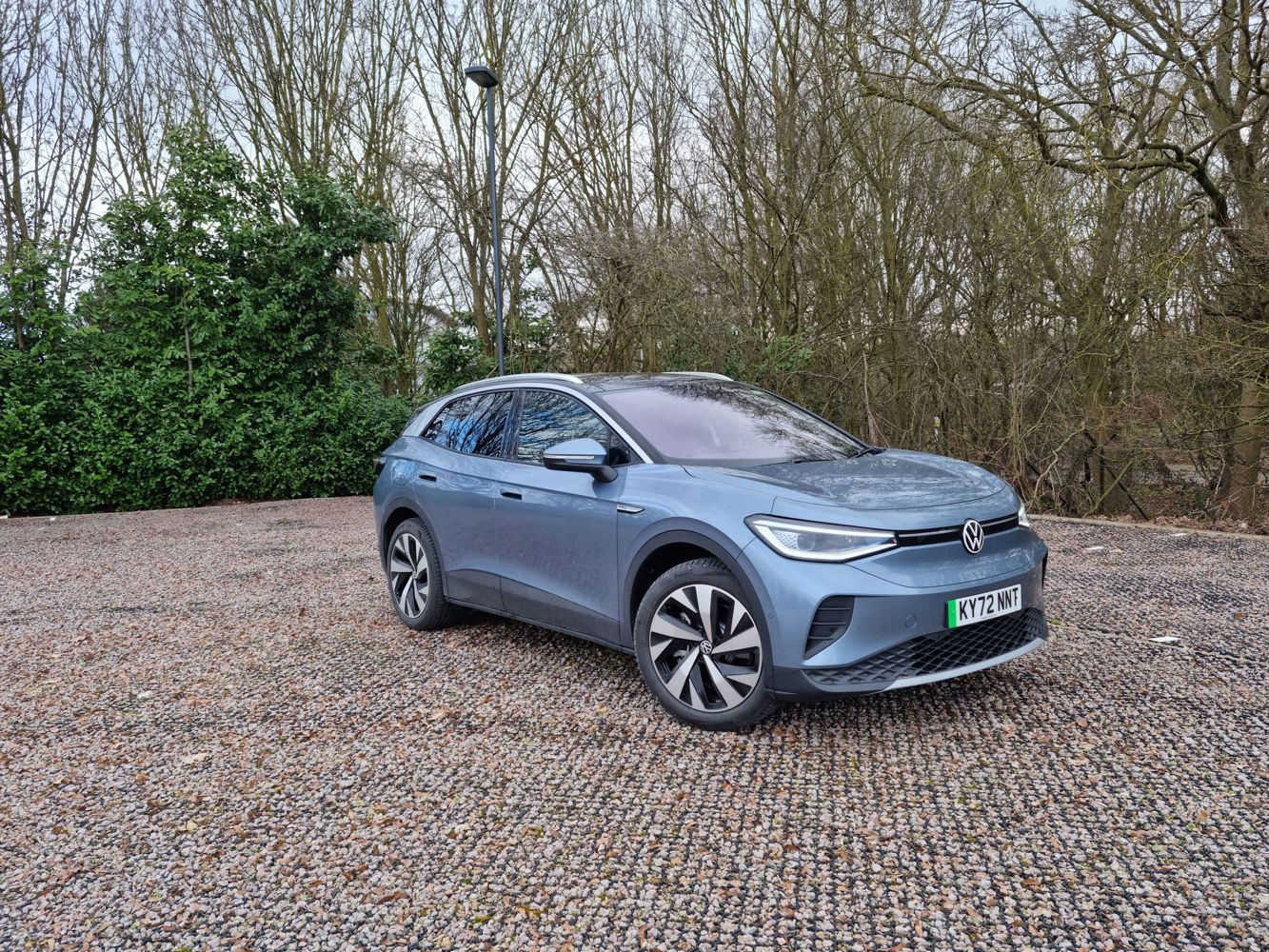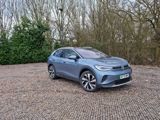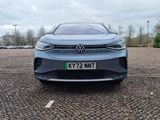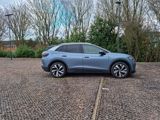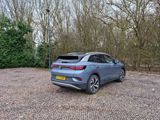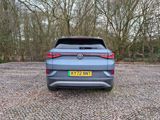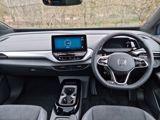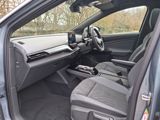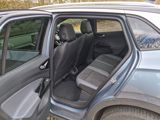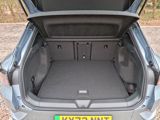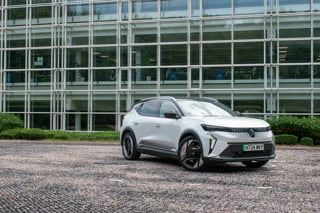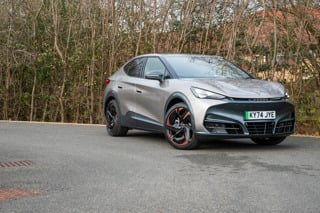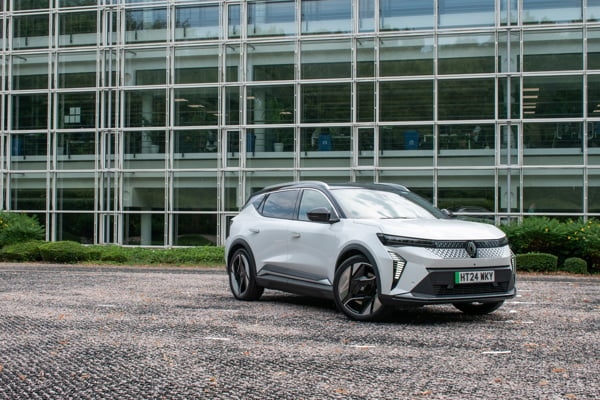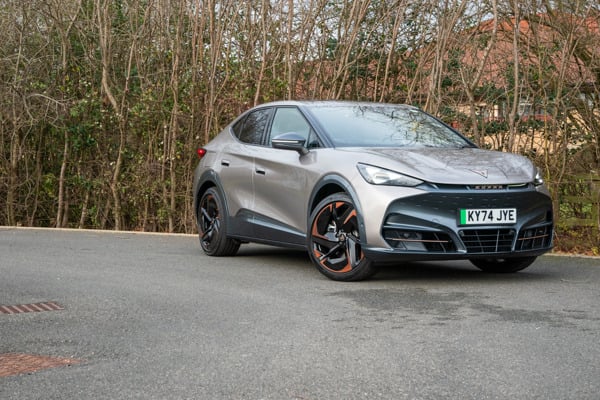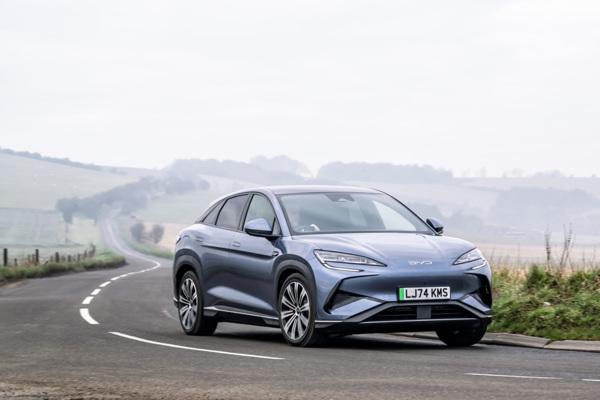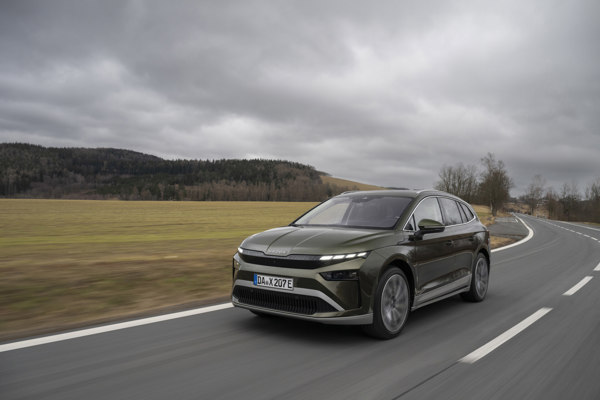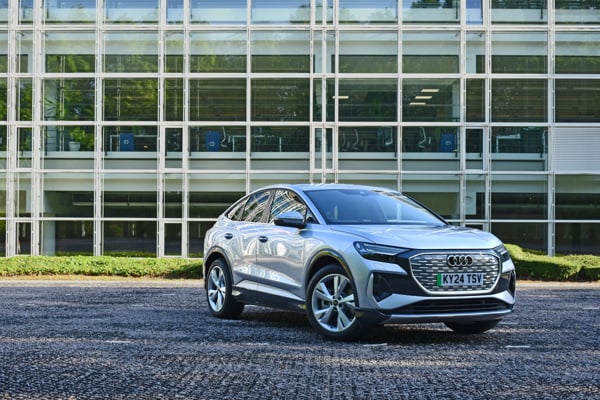Review
Highly commended in the Fleet News Awards 2021 as one of the best zero emission cars on the market, the ID4 has become a firm favourite with company car drivers, selling 8,032 models in the first 11 months of 2023, up year-on-year by 44%, with true fleet up 84% at 5,686 units.
While the ID3 is the natural EV successor to the Golf, one of the most successful fleet cars of all time, the larger ID4 still draws comparisons by many despite officially being a compact SUV. Its dimensions are similar, although it doesn’t quite have the Golf’s personality (some might argue the Golf’s illustrious status has diminished in recent years, overwhelmed by a flood of high quality, technology packed new entrants).
However, the ID4 has plenty of neat elements to appeal to company car buyers, such as the excellent infotainment system and ID Light (more on this below).
The two key questions, though, are does it work as an electric car – i.e. should you swap out of your petrol or diesel model – and is it better than rival electric cars?
In short, the answers are yes and maybe – but that’s not to say the ID4 isn’t deserving of your attention. Personal preference is always subjective.
Why does it work as an electric company car? Obviously BIK – at 2%, just £16 would be taken from the monthly wage of a 20% taxpayer.
But there are also attractive practicalities: WLTP range of 322 is decent for the 77kWh battery, although our on-test average efficiency of 3.7mi/kWh (max achieved was 4.4mi/kWh) gives a lower real-world journey of 277 miles. Meanwhile, a zero to 100% overnight charging time of 12 hours on a 7kW home charger, reducing to just 38 mins to 80% on a 125kW DC rapid charger, mean the ID4 can fulfil most drivers’ daily needs.
It's worth noting that VW has updated the powertrain in the ID4 since our test car was built so all newly order models will be fitted with a new, more powerful motor and promise an extra 10 miles of range.
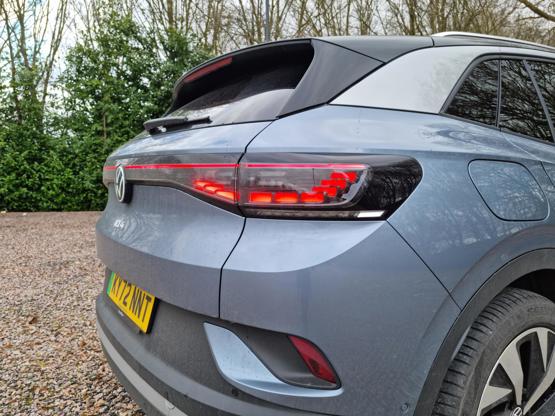
The ID4 is spacious for occupants and their luggage, and among the surprise and delight features is ID Light, the intelligent light trip at the base of the windscreen which flashes different colours to communicate with the driver (pulsing blue when approaching a junction, green when charging or flaring red as an alert to a potential crash).
So, why might it not be the best? Range is decent, but not sector leading. The Hyundai Ioniq 5, with a 73kW battery, has a WLTP range of 315 miles, but we regularly nudged real-world 300 miles with an on-test average efficiency of 4mi/kWh (note, some journeys topped 5mi/kWh).
The Ioniq 5 is also well equipped, has universally loved looks – it’s sold 5,742 true fleet models this year - but has a total cost of ownership of 53.64ppm on a four-year/80,000-mile operating cycle (let down by its residual value, which we believe has been under-forecast by the pricing guides). The ID4, in comparison, is 47.85ppm.
We’ve also had a few quality issues to content with on the ID4 (detailed in previous reviews lower down).
Nevertheless, the ID4 is certainly up there, if not necessarily best in class, and it should definitely be on the choice list. Badge also remains important for many, and Volkswagen still has that appeal.
Running costs "highly competitive"
In last month’s review we highlighted some of the niggles and concerns we’d unearthed during our time with the Volkswagen ID4, which now stretches to five months.
So, it’s only fair we now consider some of the reasons why this battery electric car is an excellent choice for both a fleet and a company car driver.
First, the company perspective. Running costs on the ID4 are highly competitive over a four-year/80,000-mile operating cycle.
In a basket containing the Mustang Mach-E, Hyundai Ioniq 5 and Tesla Model Y (all priced around £48,000, except the Tesla at £44,000), the ID4 is beaten only by the Model Y and only then because of that model’s incredibly low depreciation, according to Cap HPI’s forecast data.
The ID4 has the lowest SMR cost at just 3.19p per mile (ppm), which, in additional to cheaper parts, also indicates an expectation of excellent reliability – and less time off the road will result in lower whole life costs and a more productive employee. On SMR, the Tesla loses out, with a comparatively weighty 6.12ppm.
The Ioniq 5 has the highest running cost at 53.64ppm, closely followed by the Mach-E (52.48ppm). The ID4 is a more impressive 47.85ppm but the Model Y takes the plaudits by a considerable margin, at 41.51ppm.
Evaluating the ID4 against ICE alternatives within the Volkswagen stable makes interesting reading. The petrol T-Cross, for example, costs 42.80ppm, despite a P11D price of just £28,370, while a comparative Golf is 39.67ppm (diesel) and 41.42ppm (petrol).
Over the 80,000-mile lifecycle, the running cost of the ICE options is around £5,000 less than the ID4, although they are substantially higher on employee BIK. Fleets do need to check the total cost of ownership, though, for the full picture.
Overall running costs data:
- Tesla Model Y: 41.51ppm – fuel 10.34ppm; SMR 6.12ppm; depreciation 25.05ppm
- Volkswagen ID4: 47.85ppm – fuel 10.40ppm; SMR 3.19ppm; depreciation 34.26ppm
- Mustang Mach-E: 52.48ppm – fuel 10.52ppm; SMR 3.80ppm; depreciation 38.16ppm
- Hyundai Ioniq 5: 53.64ppm – fuel 11.01ppm; SMR 4.32ppm; depreciation 38.31ppm
What about the employee perspective?
As a full electric model, the ID4 sits in the lowest BIK tax bracket of 2%; with a P11D of £47,955, our model would cost a 20% taxpayer just £16 per month. A big tick, then, during the cost of living crisis.
At a recent event, the ID4 was parked next to its premium brethren, the Audi Q4 e-tron. The similarities were striking: internal door fixtures and fittings are identical, with the ID4 offering the same tactile, high quality materials for a like-for-like c£3,000 price saving (or 2.5ppm on running costs – over 80,000 miles, a £2,000 saving). The main difference was the dashboard and infotainment layouts. Take the saving or opt for the badge? It’s your call.
Those undergoing longer journeys will appreciate the supportive seats. Although our model does not have adjustable lumbar support, the front seats cushion the occupant and provide an excellent driving position.
And those long journeys can return impressive efficiency, given a patient right foot. A recent 240-mile round trip to West Yorkshire was achieved in 4.4mi/kWh – primarily thanks to a self-imposed 62mph on the motorway sections.
That would’ve given a potential range of 339 miles – a 5% gain (17 miles) over the official WLTP figure of 322. The subsequent recharge to full also resulted in our highest starting range yet of 310 miles.
The overall proof of the ID4’s popularity can be seen in the registration figures. While its total market units have risen 81% year-on-year, its true fleet volumes have exploded, with a massive 268% growth in the first half of the year, from 990 to 2,649.
The things we don't like
Month four with the Volkswagen ID4 and, among the many positives effused in previous reviews, it’s time to pick up on a few issues and concerns we’ve discovered over that time.
We’ve already highlighted the malfunctioning off-side passenger door, which for a few weeks refused to open from the inside. It has since corrected itself after some enthusiastic lock/unlock pressing of the key fob – thanks to one of the several forums for that nugget of advice.
Another issue we’ve been living with is the poor quality seal around the frameless front windows. On the driver’s side, it has a tendency to fold the wrong side of the window (i.e. inside the glass) when wound down.
This causes the window to wind down when you want it to close, wind up v-e-r-y slowly, or jam completely.
Leveraging the seal so it sits on the outside of the glass offers a temporary situation, as it generally returns to its preferred position the next time the window is opened.
The seal itself seems flimsy compared to other the frameless windows on other cars, which have stiffer rubber. Fortunately, it hasn’t happened on the near-side window.
Among the pluses, we like the fact that the car is primed and ready to go when you get in – there’s no need to press the engine start button; just select drive and away you go.
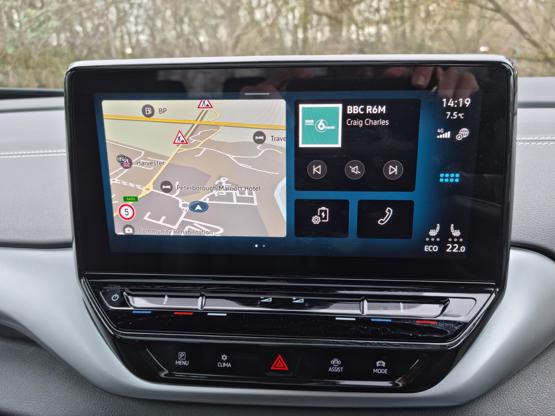
Where that becomes a slight annoyance is when trying to switch the car off: it doesn’t disengage the aircon and radio until you leave the driver seat. If you are still in the car, say waiting for someone, the convenience features remain active, slowly sapping the electric charge.
My solution is to lock and then unlock the car and leave the door slightly ajar. I’ve yet to find a way to override it so everything switches off when the stop button is pressed.
Our only other minor niggle is the fact that the infotainment system doesn’t automatically connect Apple CarPlay – at least it doesn’t every time. Usually you have to click the icon on the screen and then confirming by clicking ok to connect, which seems unnecessary.
None of the above are reasons to overlook the Volkswagen ID4, of course – but they are worth bearing in mind when comparing prospective company cars. Scroll down to previous reviews where we offer plenty of reasons why this car should be on the consideration list.
Beating the WLTP range
With the weather now regularly in the mid-teens, the efficiency performance of the Volkswagen ID4 has soared.
Journeys now average 3.6-4mi/kWh and have reached as high as 4.4. The latter figure would take maximum range to a WLTP-busting 330 miles. That’s 100 miles more than we were achieving in the colder weather.
We’re finding it easy to live with the ID4. Its compact exterior proportions (it’s shorter than the Mustang Mach-E and Hyundai Ioniq 5) mask a spacious interior with the lengthy 2,771mm wheelbase and flat floor resulting in ample head, leg and arm room for front and rear passengers.
The 543-litres boot capacity is generous (and bigger than the Mach-E and Ioniq 5), while beneath the false floor, even more items can be stored, making the SUV a perfect companion for family getaways. There is no storage area under the bonnet, though.
It takes a while to get used to the gearshift. Instead of a conventional lever, the selector is a rocker switch protruding from the top right of the steering column-mounted instrument panel screen. It requires a twist to select drive or reverse.
Twist forward twice to select ‘B’ for brake energy recuperation, which means the car recovers more energy when lifting off the accelerator and braking. So far, we’ve not used this option as we were waiting for the range to settle down to make a proper comparison. We’ll report back in a future test on the performance of the energy recovery.
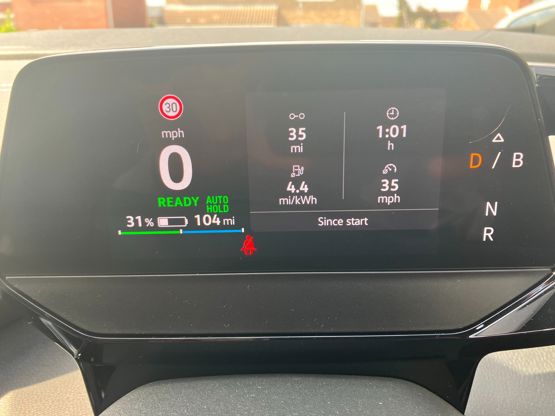
The ID4 has a neat feature: it communicates with the driver through an intelligent strip of light at the base of the windscreen.
When a destination has been put into the sat-nav, the ID Light denotes upcoming turns by flowing a bead of aquamarine light in the direction of the turn, like an indicator.
It pulses blue when the car is approaching a change in road setting, such as a junction, roundabout or speed limit. And it flares bright red if it senses a risk of an imminent crash or in the event of an emergency stop.
ID Light welcomes the driver by flashing white then blue to let them know the vehicle is ready to use, and it pulses with a green status bar during charging.
We found it a useful visual aid, particularly when using the sat-nav – a helpful alternative to a head-up display.
For a 10-day period, we have had to experience life without a home charger after our Pod Point stopped working. Fortunately, the situation has been rectified with a new circuit board after remote diagnosis didn’t solve the problem, but it did give an opportunity to live with the car without the option of charging at home.
Fortunately, with a 17-mile commute to an office with charging, it wasn’t a huge burden but on a couple of occasions we cut it very fine, down to the final 10 miles.
Public charging was, of course, the alternative solution – albeit at much higher cost - but with mainly short journeys over that time, we were able to cope by relying on workplace chargers.
More than just an electric Golf
It appears there is a known issue with the child locks on the 2023 ID4 model – a Google search brings up various forums complaining about the problem.
Within a couple of weeks of taking delivery of our new long termer, the offside rear passenger door developed a fault and stubbornly refused to be opened from the inside. The car logged it as a fault within the onboard computer.
On the driver forums, some owners recommended pressing lock-unlock twice in quick succession which didn’t work but just as we considered taking the ID4 to the local dealership, the problem went away. All doors are now fully functioning.
Such is the compactness of this compact SUV’s exterior proportions that a few people have asked whether it is VW’s electric version of the Golf. The company did briefly have an e-Golf, but its limited range meant it won few fans.
The ID4’s dimensions are similar, but bigger – 4,584/2,108/1,634mm (length/width/height) versus the Golf’s 4,258/2,027/1,492mm – but it’s inside where the differences really become clear.
The ID4 has a 2,771mm wheelbase, for decent legroom, and 1,066/979mm front/rear headroom, while the Golf offers a 2,620mm wheelbase and 1,018/967mm headroom in comparison. Luggage capacity is also firmly in the ID4’s favour at 543 litres versus the Golf’s modest 380.
We’ll focus more on the ID4’s interior features in our third review.
The biggest question anyone asks about this car – indeed any electric car – is, of course, what’s the range. The answer very much depends on the weather or, more precisely, the temperature.
Range during cold weather hovers around 220-230 miles, rather less than the 322-mile WLTP combined figure, with efficiency just about hitting 3mi/kWh (WLTP: 3.9), although many trips hover around 2.8-2.9. However, more recently, with temperatures starting to regularly exceed 10 deg C, the same journeys have resulted in 3.5-3.6mi/kWh, taking the potential range to around 270 miles.
That’s still lower than our previous full electric long termer, the Hyundai Ioniq 5, which we had during warmer weather and comfortably achieved 4mi/kWh, sometimes even exceeding 5mi/kWh, on similar routes.
It’ll be interesting to see if the ID4 can get anywhere near that as the weather continues to warm. We’ll let you know!
VW ID4 Pro Style 77kWh joins our fleet
The ID4, build on the brand’s modular electric drive matrix (MEB) platform which also underpins the ID3, has been designated a ‘net climate-neutral product’ by German audit body TUV Nord as it is built at net carbon-neutral plants using renewable energy, while suppliers are use renewable energy. Any unavoidable emissions are offset through climate protection projects.
With ID models accounting for around 14% of Volkswagen UK’s cars sales last year (just over 18,200 units of ID3, ID4 and ID5), the cars have a vital role to play in shoring up VW’s future as a sustainable brand.
The ID4 comes with three body derivatives: Life Edition and Style, both rear-wheel drive with a choice of 52kWh or 77kWH, plus the all-wheel drive GTX with 77kWh battery and 295hp. We have Style with the 77kWh battery which has a WLTP range of 322 miles. The ID4 model range has been updated, click here to see the latest versions and prices.
All batteries come with an eight year/100k warranty.
Charging times range from almost 13 hours on 7kW and 7.5hrs on 11kW (both to 100%), to just 38 mins on a 125kW DC rapid charge (to 80%).
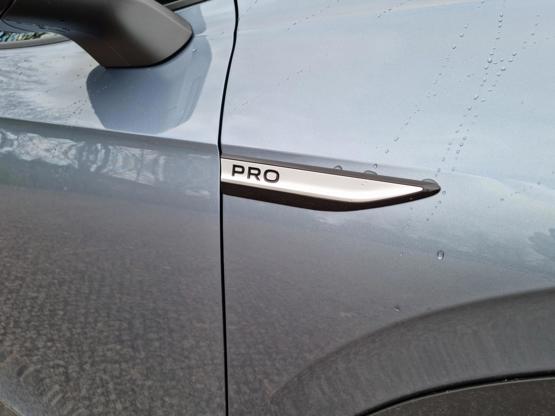
As with many electric models, levels of standard equipment are high and include driver alert system with fatigue detection, park assist with front/rear sensors and rear parking camera, lane assist, oncoming vehicle braking when turning and swerve support, dynamic road sign display and 10-inch infotainment display.
The ID4 is also one of the first models to feature advanced connectivity technology: Car2X allows it to wirelessly exchange information about local hazards with other vehicles and the traffic infrastructure.
In addition, the WeConnect app provides information such as battery range, vehicle health and vehicle locator as well as allowing drivers to pre-set air-con levels based on departure times.
Additional kit on our test car includes energy efficient heat pump (£1,050), 20-inch alloys (£500), 3-pin mains charging cable (£190) and stonewashed blue metallic paint with black roof (£690) which take the P11D price from £47,995 to £50,425.
Initial impressions are good, although with the cold snap recently experienced, range indication is closer to 230 miles with an efficiency just nudging 3mi/kWh.
Acceleration is quick but not explosive and handling precise and well-weighted, while the car grips to the road with minimal body roll, despite weighing in at more than two tonnes, thanks to a low centre of gravity.
As a family car, the ID4 rightly prioritises security and calmness over outright fun, but more on that in future tests.
Specs
| Manufacturer | Volkswagen |
| Model | ID.4 |
| Specification | ID.4 SUV 0.0Electric Pro 77kWh 174 Style Edition Auto 23MY |
| Model Year | 0.00 |
| Annual VED (Road tax) | £0 |
| BIK List Price | £47,955 |
| CO2 | N/A |
| BIK Percentage | 2% |
| Insurance Group | N/A |
| CC | N/A |
| Fuel Type | Electric |
| Vehicle Type | SUV and Crossover |
| Luggage capacity (Seats up) | 5litres |
Running Costs
| P11D | £47,955 |
| Insurance group | N/A |
| Fuel Type | Electric |
| Cost per mile | 112.78ppm |
| Fuel | 7.56ppm |
| Depreciation | 103.45ppm |
| Service maintenance and repair | 1.77ppm |
Rivals
Info at a glance
-
P11D Price
£47,955
-
MPG
N/A -
CO2 Emissions
N/A -
BIK %
2% -
Running cost
3 Year 60k : N/A 4 Year 80k : N/A -
Fuel Type
Electric



